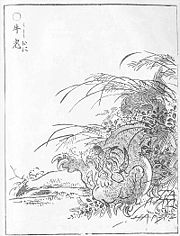
Ushi-Oni
Encyclopedia

Folklore
Folklore consists of legends, music, oral history, proverbs, jokes, popular beliefs, fairy tales and customs that are the traditions of a culture, subculture, or group. It is also the set of practices through which those expressive genres are shared. The study of folklore is sometimes called...
of Japan
Japan
Japan is an island nation in East Asia. Located in the Pacific Ocean, it lies to the east of the Sea of Japan, China, North Korea, South Korea and Russia, stretching from the Sea of Okhotsk in the north to the East China Sea and Taiwan in the south...
. There are various kinds of ushi-oni, all of them some sort of monster with a horned, bovine head.
Perhaps the most famous ushi-oni appears as a protective symbol in the Ushi-oni-matsuri
Japanese festivals
Japanese festivals are traditional festive occasions. Some festivals have their roots in Chinese festivals but have undergone dramatic changes as they mixed with local customs....
, which is held in late July in Uwajima of Ehime Prefecture
Ehime Prefecture
is a prefecture in northwestern Shikoku, Japan. The capital is Matsuyama.-History:Until the Meiji Restoration, Ehime prefecture was known as Iyo Province...
. Something like the dragon dance
Dragon dance
Dragon dance is a form of traditional dance and performance in Chinese culture. Like the lion dance it is most often seen in festive celebrations. Many Chinese people often use the term "Descendants of the Dragon" as a sign of ethnic identity, as part of a trend started in the 1970s. Another...
rs at a Chinese New Year
Chinese New Year
Chinese New Year – often called Chinese Lunar New Year although it actually is lunisolar – is the most important of the traditional Chinese holidays. It is an all East and South-East-Asia celebration...
celebration, this ushi-oni is represented with a huge, multiple-person costume with a cloth body and a carved, painted head held upon a pole. It has a sword for a tail, and is thought to drive away evil spirits.
Another well-known ushi-oni is a massive, brutal sea-monster which lives off the coast of Shimane Prefecture
Shimane Prefecture
is a prefecture of Japan located in the Chūgoku region on Honshū island. The capital is Matsue. It is the second least populous prefecture in Japan, after its eastern neighbor Tottori. The prefecture has an area elongated from east to west facing the Chūgoku Mountain Range on the south side and to...
and other places in Western Japan and attacks fishermen. It is often depicted with a spider- or crab-like body. This ushi-oni seems to be connected to another monster called the nure-onna
Nure-onna
A is an amphibious creature with the head of a woman and the body of a snake. While the description of her appearance varies slightly from story to story, she has been described as being 300 m in length and has snake-like eyes, long claws, fangs and long, beautiful hair. She is typically spotted...
, who sometimes appears before an ushi-oni attack and tricks the victim into holding her child, which then becomes stuck to the person's hands and grows heavier in order to hinder escape.
Yet another ushi-oni is depicted as a statue on the grounds of the Negoroji temple in Takamatsu
Takamatsu, Kagawa
is a city located in central Kagawa Prefecture on the island of Shikoku in Japan, and is the seat of the prefectural government. It is designated a core city by the Japanese Government. It is a port city located on the Seto Inland Sea, and is the closest port to Honshu from Shikoku island...
, Kagawa Prefecture
Kagawa Prefecture
is a prefecture of Japan located on Shikoku island. The capital is Takamatsu.- History :Kagawa was formerly known as Sanuki Province.For a brief period between August 1876 and December 1888, Kagawa was made a part of Ehime Prefecture.-Battle of Yashima:...
. It is a bipedal monster with huge tusks, spurred wrists, and membranes like a flying squirrel. A sign nearby explains that this creature terrorized the area about four-hundred years ago, and was slain by a skilled archer by the name of Yamada Kurando Takakiyo (山田蔵人高清). He dedicated its horns to the temple, and they can still be seen to this day.
Ushi-oni are also mentioned in Sei Shōnagon
Sei Shonagon
Sei Shōnagon , was a Japanese author and a court lady who served the Empress Teishi around the year 1000 during the middle Heian period. She is best known as the author of The Pillow Book .-Name:...
's tenth-century diary The Pillow Book
The Pillow Book
is a book of observations and musings recorded by Sei Shōnagon during her time as court lady to Empress Consort Teishi during the 990s and early 11th century in Heian Japan. The book was completed in the year 1002....
, and in the Taiheiki
Taiheiki
The is a Japanese historical epic , written in the late 14th century. It deals primarily with the Nanboku-chō, the period of war between the Northern Court of Ashikaga Takauji in Kyoto, and the Southern Court of Emperor Go-Daigo in Yoshino....
of the fourteenth century.

